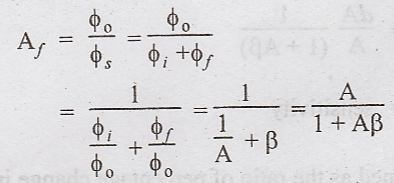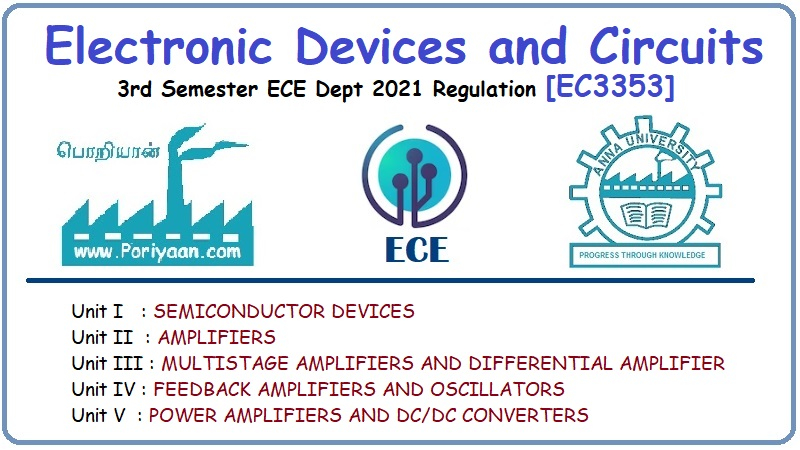Electronic Devices and Circuits: Unit IV: Feedback Amplifiers and Oscillators
Introduction of Feedback Amplifiers
Basic Concept of Feedback
Harold Black of Western Electric Company invented electronic feedback concept in 1928. When he was working on repeaters for telephone lines. Feedback plays a very important role in electronic circuits and the basic parameters such as input impedance, output impedance, current or voltage gain and bandwidth may be altered considerably by the use of feedback for a given amplifier.
INTRODUCTION OF FEEDBACK AMPLIFIERS AND OSCILLATORS
Harold
Black of Western Electric Company invented electronic feedback concept in 1928.
When he was working on repeaters for telephone lines. Feedback plays a very
important role in electronic circuits and the basic parameters such as input
impedance, output impedance, current or voltage gain and bandwidth may be
altered considerably by the use of feedback for a given amplifier.
The
feedback can be either negative (degenerative) or positive (regenerative). Most
desirable performance parameters of the basic amplifiers can be improved when
negative feedback is used. Negative feedback is used in amplifiers and filters
while positive feedback is used in oscillators.
The
only disadvantage of negative feedback is the reduction of transfer gain. The
basic idea behind the use of negative feedback is to trade-off transfer gain
for other desirable properties.
BASIC CONCEPT OF FEEDBACK
A
block diagram of an amplifier with feedback is shown in Fig.4.1.
The
output quantity is sampled by a suitable sampler, which is of two types, namely
voltage sampler, and current sampler, and fed to the feedback network.
The output of feedback network that has a fraction of the output signal is combined with external source signal φs through a mixer and fed to the basic amplifier.

Mixer
also called as comparator is of two types namely series comparator and shunt
comparator.

Types
There
are two types of feedback
(i)
Positive feedback
(ii)
Negative feedback
i. Positive Feedback
(Regenerative Feedback)
If
the feedback signal φf is in phase with input signal φS then the net
effect of the feedback will increase the input signal given to the amplifier.
ie., φi = φS + φf. Hence, the input voltage
applied to the basic amplifier is increased thereby increasing φO
exponentially.
Gain
of the amplifier with positive feedback is

Here
|Af| > |A|. The product of the open loop gain and the feedback
factor is called the loop gain ie loop gain = Aβ. If |Aβ|= 1, then Af
= ∞, hence the gain of the amplifier with positive feedback is infinite and the
amplifier gives an ac output without ac input signal. Thus the amplifier acts
as an oscillator.
The
positive feedback increases the instability of an amplifier reduces the
bandwidth and increases the distortion and noise.
The
property of the positive feedback is utilized in oscillators.
ii. Negative Feedback
(Degenerative Feedback)
If
the feedback signals, φf is out of phase with the input signal φS.
Then φi = φS- φf, so the input voltage applied
to the basic amplifier is decreased and correspondingly the output is
decreased. Hence, the voltage gain is reduced. This type of feedback is known
as negative or degenerative feedback.
Gain
of the negative feedback amplifier is

|Af|
< |A|. If |Aβ| >> 1 then Af = 1/β, where β is a feedback
ratio. Hence the gain depends less on the operating potentials and the
characteristics of the transistor or vacuum tube.
The
gain may be made to depend entirely on the feedback network. If the feedback
network contains only stable passive elements the gain of the amplifier using
negative feedback is also stable.
Advantages
of Negative Feedback
i.
Helps to increase the bandwidth
ii.
Decreased distortion and noise
iii.
Modification of input and output resistance as desired.
Electronic Devices and Circuits: Unit IV: Feedback Amplifiers and Oscillators : Tag: : Basic Concept of Feedback - Introduction of Feedback Amplifiers
Related Topics
Related Subjects
Electronic Devices and Circuits
EC3353 - EDC - 3rd Semester - ECE Dept - 2021 Regulation | 3rd Semester ECE Dept 2021 Regulation
